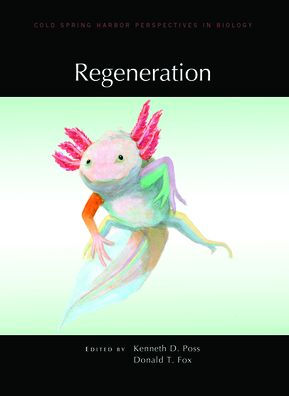Regeneration
The formation of new cells, tissues, and organs enables animals to recover from day-to-day wear and tear, injury, and disease. Some animals, such as sea stars, planarians, and lizards, can regenerate entire limbs and other body parts. But in mammals, including humans, some tissues (e.g., heart muscle) are more resistant to regeneration.
Written and edited by experts in the field, this collection from Cold Spring Harbor Perspectives in Biology explores the biological basis of regeneration in diverse animal species and how this knowledge can be applied therapeutically in humans. The contributors discuss the dramatic molecular and cellular changes that occur when a regeneration program is initiated, the progenitor cells and morphogenic signals involved, the formation of a blastema, the roles of reprogramming and polyploidy, the diversity of cell fates, the integration of new structures with existing body parts, and our current understanding of why some structures are more resistant to regeneration than others. The importance of technologies (e.g., single-cell RNA-seq) that have been instrumental in deciphering various aspects of regeneration in recent years is emphasized throughout.
Examples of regeneration in flatworms, Hydra, insects, salamanders, frogs, fish, and mammals are described. Several chapters are also devoted to regeneration in specific human organs—the skin, retina, heart, lung, pancreas, liver, skeletal muscle, and intestine—and examine possibilities for therapeutically replacing injured or diseased structures and for managing age-related declines in function. This volume is therefore essential reading for molecular, cell, and developmental biologists studying regeneration in animals, as well as for all interested in the development of regenerative therapies for clinical application.
1139997495
Written and edited by experts in the field, this collection from Cold Spring Harbor Perspectives in Biology explores the biological basis of regeneration in diverse animal species and how this knowledge can be applied therapeutically in humans. The contributors discuss the dramatic molecular and cellular changes that occur when a regeneration program is initiated, the progenitor cells and morphogenic signals involved, the formation of a blastema, the roles of reprogramming and polyploidy, the diversity of cell fates, the integration of new structures with existing body parts, and our current understanding of why some structures are more resistant to regeneration than others. The importance of technologies (e.g., single-cell RNA-seq) that have been instrumental in deciphering various aspects of regeneration in recent years is emphasized throughout.
Examples of regeneration in flatworms, Hydra, insects, salamanders, frogs, fish, and mammals are described. Several chapters are also devoted to regeneration in specific human organs—the skin, retina, heart, lung, pancreas, liver, skeletal muscle, and intestine—and examine possibilities for therapeutically replacing injured or diseased structures and for managing age-related declines in function. This volume is therefore essential reading for molecular, cell, and developmental biologists studying regeneration in animals, as well as for all interested in the development of regenerative therapies for clinical application.
Regeneration
The formation of new cells, tissues, and organs enables animals to recover from day-to-day wear and tear, injury, and disease. Some animals, such as sea stars, planarians, and lizards, can regenerate entire limbs and other body parts. But in mammals, including humans, some tissues (e.g., heart muscle) are more resistant to regeneration.
Written and edited by experts in the field, this collection from Cold Spring Harbor Perspectives in Biology explores the biological basis of regeneration in diverse animal species and how this knowledge can be applied therapeutically in humans. The contributors discuss the dramatic molecular and cellular changes that occur when a regeneration program is initiated, the progenitor cells and morphogenic signals involved, the formation of a blastema, the roles of reprogramming and polyploidy, the diversity of cell fates, the integration of new structures with existing body parts, and our current understanding of why some structures are more resistant to regeneration than others. The importance of technologies (e.g., single-cell RNA-seq) that have been instrumental in deciphering various aspects of regeneration in recent years is emphasized throughout.
Examples of regeneration in flatworms, Hydra, insects, salamanders, frogs, fish, and mammals are described. Several chapters are also devoted to regeneration in specific human organs—the skin, retina, heart, lung, pancreas, liver, skeletal muscle, and intestine—and examine possibilities for therapeutically replacing injured or diseased structures and for managing age-related declines in function. This volume is therefore essential reading for molecular, cell, and developmental biologists studying regeneration in animals, as well as for all interested in the development of regenerative therapies for clinical application.
Written and edited by experts in the field, this collection from Cold Spring Harbor Perspectives in Biology explores the biological basis of regeneration in diverse animal species and how this knowledge can be applied therapeutically in humans. The contributors discuss the dramatic molecular and cellular changes that occur when a regeneration program is initiated, the progenitor cells and morphogenic signals involved, the formation of a blastema, the roles of reprogramming and polyploidy, the diversity of cell fates, the integration of new structures with existing body parts, and our current understanding of why some structures are more resistant to regeneration than others. The importance of technologies (e.g., single-cell RNA-seq) that have been instrumental in deciphering various aspects of regeneration in recent years is emphasized throughout.
Examples of regeneration in flatworms, Hydra, insects, salamanders, frogs, fish, and mammals are described. Several chapters are also devoted to regeneration in specific human organs—the skin, retina, heart, lung, pancreas, liver, skeletal muscle, and intestine—and examine possibilities for therapeutically replacing injured or diseased structures and for managing age-related declines in function. This volume is therefore essential reading for molecular, cell, and developmental biologists studying regeneration in animals, as well as for all interested in the development of regenerative therapies for clinical application.
135.0
In Stock
5
1

Regeneration
460
Regeneration
460Hardcover
$135.00
135.0
In Stock

Product Details
| ISBN-13: | 9781621824091 |
|---|---|
| Publisher: | Cold Spring Harbor Laboratory Press |
| Publication date: | 02/28/2022 |
| Series: | Perspectives CSHL |
| Pages: | 460 |
| Product dimensions: | 7.25(w) x 10.25(h) x 1.01(d) |
From the B&N Reads Blog
